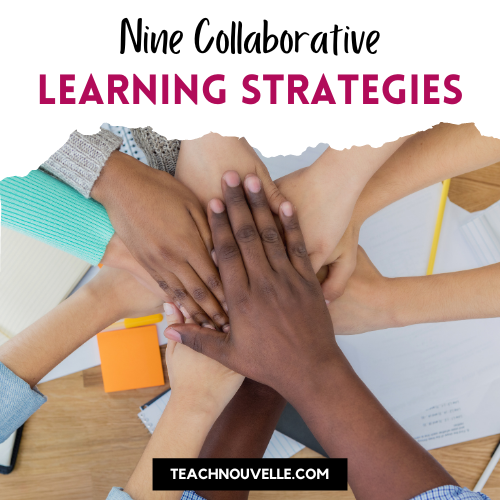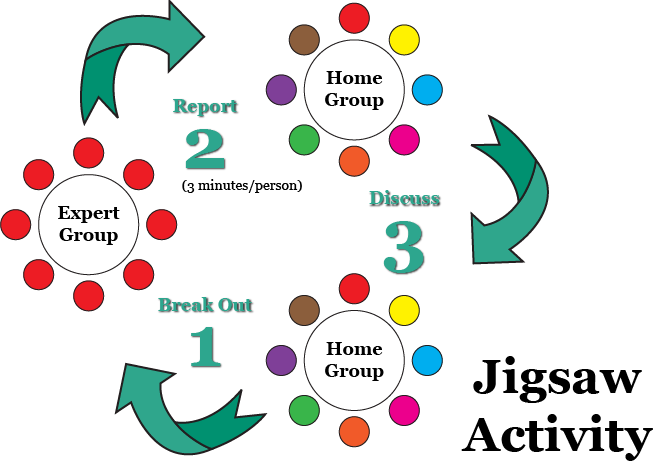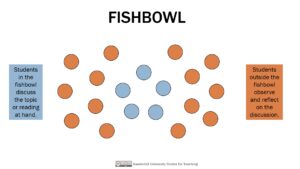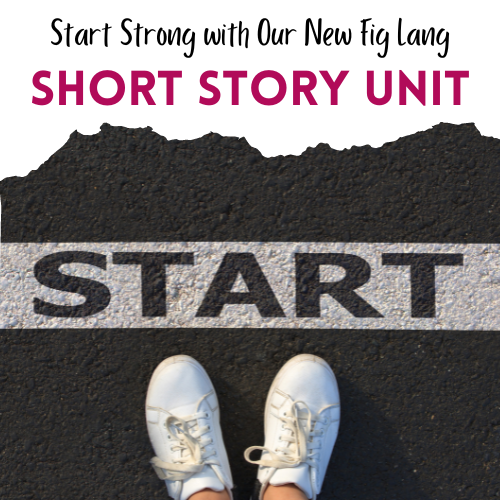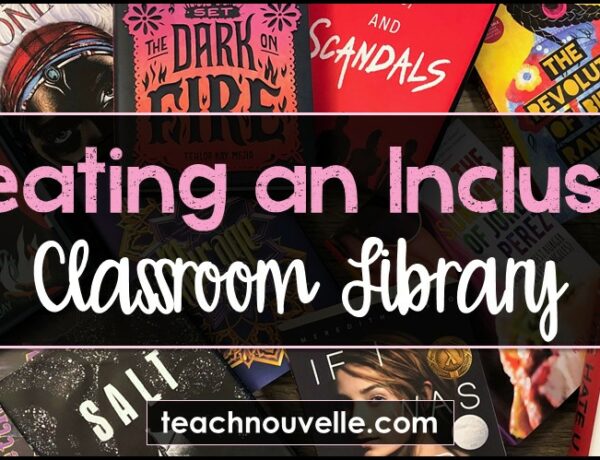Looking for collaborative learning strategies to implement in your secondary ELA classroom? These 9 strategies will promote rich academic conversations, build community, and foster effective communication for your students.
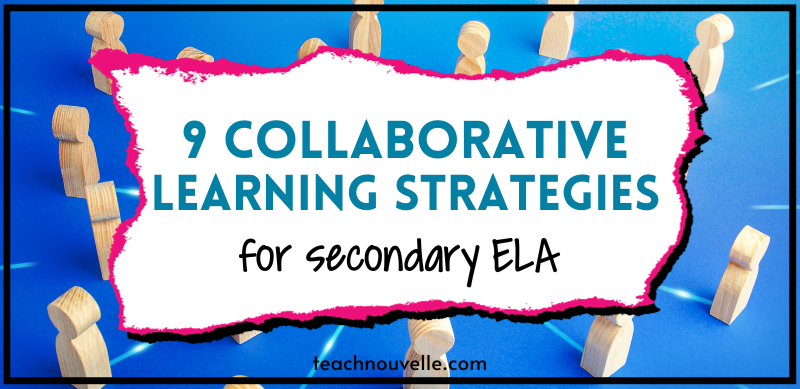
The importance of effective communication in secondary ELA classrooms
How do you promote collaboration in the classroom?
In today’s ever-evolving educational landscape, fostering effective communication in Secondary ELA classrooms has become more crucial than ever before. Collaborative learning strategies have emerged as a powerful tool to encourage student engagement, critical thinking, and problem-solving skills.
This blog post walks you through nine collaboration strategies that can significantly enhance communication skills in ELA classrooms, which empowers students to express their thoughts and ideas confidently.
By incorporating opportunities for collaborative discussions, teachers can create a dynamic learning environment that promotes active participation and encourages students to think critically and express their ideas effectively. These strategies not only improve students’ communication skills but also cultivate essential life skills, such as teamwork, empathy, and open-mindedness.
Furthermore, effective communication is vital in preparing students for future academic and career success. In an increasingly interconnected and digital world, the ability to communicate clearly and persuasively is highly valued.
By implementing these collaboration strategies, educators can equip their students with the necessary communication skills to thrive in their personal and professional lives. Join us as we delve into the world of collaboration strategies and discover how they can transform your secondary ELA classroom into a hub of effective communication and vibrant discussions.
Collaborative Learning Strategies
Jigsaw is my most commonly used collaborative learning strategy. I LOVE that students get to become experts and teach other students; this is the highest level of learning a student can accomplish!
Here’s how it works:
Groups of 4-5 students work together on a discussion topic. Then, one member from each group joins one member from every other group to create new configurations.
This is an excellent strategy if you have different topics in the first round of discussion (ex: Plot, Characters, Conflict, Theme)–then, your groups would have one “expert” from each original topic.
The above image from the Learning Center accurately depicts the Jigsaw method.
We recommend the Jigsaw as one of the go-to collaborative learning strategies for our 15 Pop Culture Analysis Activities.
(P.S. The pop culture resource includes chapter 1 from the Terminus series, a digital escape room, which is another great way to increase collaboration and executive functioning).
Station Rotation is my second most used collaborative learning strategy. I love any opportunity that gets students moving around. It’s also great to implement in various spaces, like the library, outdoors, etc.
Here’s how it works:
Several questions, tasks, and/or materials (ex. articles, QR codes, etc.) are placed around the room. In groups, students travel to each station and complete all of the tasks.
Typically, students spend about 5-10 minutes at a station. This is a great way to get students moving around the room which increases their focus!
World Cafe and Station Rotation can often overlap and feel like the same collaborative learning strategy.
Here’s where I see the difference: station rotation has students moving to various places to learn about various topics. World Cafe is one topic explicated with different focuses or lenses, and movement isn’t required.
Here’s how it works:
Students are in groups at their tables. Typically, there is a poster or large paper with a question about an excerpt or text students are working with. Groups spend 7-8 minutes discussing and responding in writing to the question.
Then, they visit the next “world,” sit at the next “cafe,” and discuss a new question about the same (or different) excerpt. The process repeats until they’ve been “all around the world.”
Want to make it a silent world cafe? You can use paper, posters, or Google Docs for this. Students are able to write simultaneously or take turns and share their thoughts on a discussion question.
I love this strategy as a way to get quieter students engaged, especially English Language Learners who may struggle with “getting a word in edge-wise.”
Snowball is REALLY fun and enjoyed by many! It is sort of like “Think-Pair-Share” but with an extra step.
Here’s how it works:
Students mull over a discussion question alone, then share with a partner. That pair joins another pair to discuss. That quad joins another quad to discuss, etc., until you have a class discussion.
You can also implement the Snowball method as a collaborative writing activity.
Fishbowl is an effective way to get students actively listening and collaborating with their peers.
Here’s how it works:
Provide students with a topic or question they have prepared to discuss. Arrange your class to have a small inner and a larger outer circle of seats.
Assign or ask for volunteers for 4-6 students to sit in the inner circle and discuss the topic first. Students in the outer circle are expected to actively listen and observe; sometimes I have them take notes or offer helpful sticky notes to peers in the inner circle.
Throughout the discussion, students can enter and/or exit the fish bowl. I typically like to set a procedure ahead of time (ex. no person can be in the fishbowl for longer than 10 minutes).
Image from Vanderbilt Center for Teaching
Socratic seminar and fishbowl are a lot alike. They slightly vary in procedural style.
In a Socratic Seminar, half of your students make up the inner circle, and they each have an outer circle buddy. Depending on class sizes, you can have 1/4 of students in the inner circle with 2 outer circle buddies.
Day 1 – Prep: This varies from teacher to teacher, but I provide students with 4-5 questions to research and prepare responses for on a note-taking doc.
Day 2 – Socratic Seminar Round 1: Half of my students sit in the inner circle and respond to 2 out of the 4 questions for the whole class period. Their outer circle buddies reflect on their inner circle buddy and also have the job of passing up sticky notes with help—but they must stay completely silent.
Day 3 – Socratic Seminar Round 2: Students switch roles, and the new inner circle group discusses the last two remaining questions.
A few things to note:
1. I do not let the class know which questions will be discussed on which days nor which day they are in the inner circle…EXCEPT if I am differentiating for students who are SPED, ELL, and/or struggling with anxiety or other mental health issues.
2. I DO use this as an opportunity to differentiate. I will plan ahead and assign my students who struggle with the content to go during Round 2. This gives them more time to prepare, and they know which question they have.
Gallery Walks are so versatile. This collaborative learning strategy can be implemented in NUMEROUS ways, so we will just talk about a few.
Silent Gallery Walk:
Have your students created something visual or even responded to a quick entrance/exit ticket on a poster? Have them silently explore and reflect on what they view around the room.
Buddy Gallery Walk:
When I want students to discuss others’ work, I have them grab a museum buddy for the gallery walk. I often implement this as a peer feedback activity for smaller chunks of writing.
Group Poster Gallery Walk:
For activities like this group poster project, gallery walks are PERFECT to have students assessing their own work and the work of their peers…plus, it is quick and efficient!
There are so many ways you can configure and implement literature circles.
Here are some tips and tricks below:
- Create and rotate group roles within the literature circles. This helps students hold themselves accountable.
- Allow students to work with the same literature circle for a few rounds. Trust me, the collaboration quality increases when they’ve had more time to acclimate to their group. Beware though! There is a “sweet spot” and being with one group for too little or too long can hinder quality conversations.
- Give them opportunities to just simply talk about the book with open-ended questions. Too much writing can cloud the enjoyment of reading and discussing a book with others. My kids have enjoyed literature circles (or sometimes Ic call them book clubs) even more when they have the space to create questions and discussion points of their own.
Here are some ways you could implement literature circles for social justice issues and one for dystopian literature.
I saved this collaborative learning strategy for the end because MOST teachers are familiar with think-pair-share and think-pair-square.
Think-pair-share is when a student is given the chance to independently think about a question, pair up with another student, and share their thoughts.
Think-pair-square adds one layer by having one pair share their responses with another pair. Think if two students sitting side-by-side turned to share with the pair behind them…it creates a square!
I use these methods on a near-daily basis in my classroom. My favorite way to get students collaborating daily is with trivia bell ringers; here is a week’s worth of bell ringers for you to try for free!
In the beginning (and throughout the year), I implemented this strategy when we did some team trivia games.
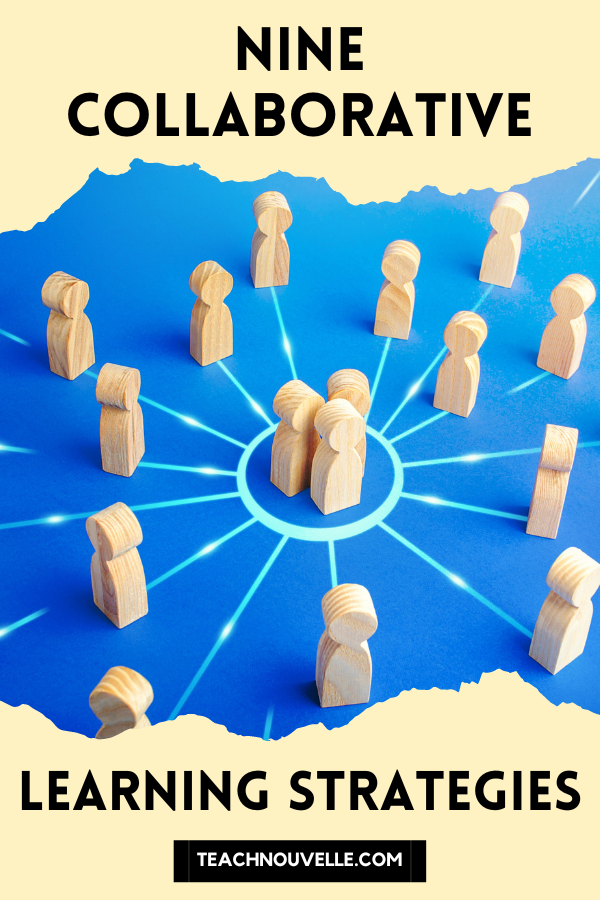
Conclusion: The impact of effective communication on student learning and success
Incorporating these nine collaborative learning strategies into your secondary ELA classroom can truly transform the learning experience for your students.
From fostering critical thinking and communication skills to promoting a sense of teamwork and shared responsibility, these methods empower both teachers and students.
So, don’t hesitate to implement these strategies and watch your classroom flourish with a newfound spirit of cooperation, creativity, and success.
Happy teaching!

